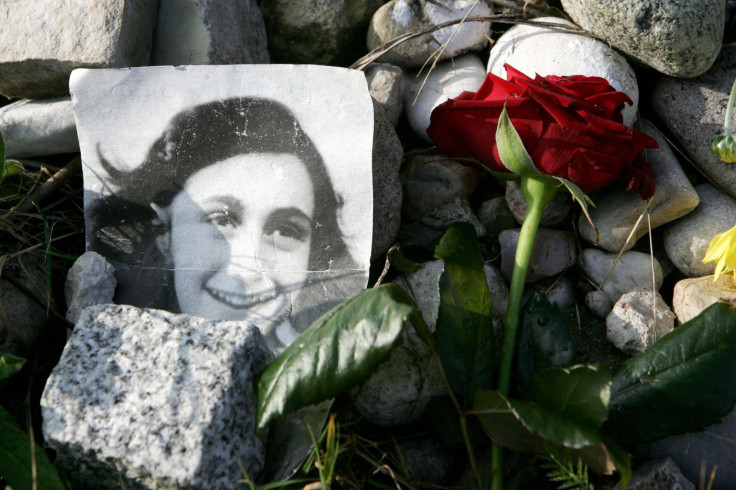Anne Frank 70th Anniversary of Arrest: History of the Diarist's Detention During the Holocaust

On the morning of 4 August 1944, following a tip from an informer who was never identified, the Amsterdam house hiding Anne Frank and her family was stormed by the Nazis.
Within minutes, the 17th century canal house at the Prinsengracht in the city centre – which had been the safehouse of the Franks for two years – was raided and their secret exposed.
The Franks, the Van Pels family and Fritz Pfeffer, a dentist and friend of the Franks, were all arrested and taken to the Reich Security Head Office headquarters where they were interrogated and held overnight.
Safehouse
Two years earlier, on 6 July 1942, the Franks moved into a secret annex within the house. The family had left their Merwedeplein apartment in disarray to create the impression that they had left suddenly, and Anne's father, Otto Frank, left behind a note that hinted plans to relocate to Switzerland.

They walked several kilometres from their home, wearing several layers of clothing to avoid carrying luggage and attract suspicion.
Their safehouse, the annex above the Opekta offices in which Otto worked, was laid out over three stories – with two small rooms and a bathroom on the first floor, two rooms on the second level, and a small room on the third floor, connected by a ladder.
The door to the Achterhuis (a Dutch word denoting the rear part of a house) was covered by a bookcase. The main building, situated a block from the Westerkerk church, was nondescript and old, typical of buildings in the western quarters of Amsterdam.
During her time in hiding, Anne wrote her diary, which was first published posthumously in France and Germany in 1950.
In her writings, Anne examined her relationships with family members, and noted the differences in their personalities.
She aspired to become a journalist, writing on Wednesday 5 April 1944: "I finally realised that I must do my schoolwork to keep from being ignorant, to get on in life, to become a journalist, because that's what I want! I know I can write… but it remains to be seen whether I really have talent."
She continued writing regularly until her last entry of 1 August 1944.
Arrest
Seventy years ago today, a group of German uniformed police, led by SS-Oberscharführer Karl Silberbauer of the Sicherheitsdienst, the intelligence agency of the SS and the Nazi Party, took the Franks, Van Pelses and Pfeffer to the RSHA headquarters.
After being held overnight, they were transferred to the Huis Van Bewaring – House of Detention – a crowded prison in the centre of Amsterdam. Two days later, they were moved to the Westerbork transit camp, through which over 100,000 Dutch and German Jews had passed by 1944.

Having been arrested in hiding, Anne and her family were considered criminals and sent to the punishment barracks for hard labour.
Deportation
On 3 September 1944, the group was deported on the final train from Westerbork to Auschwitz concentration camp.
After the three-day journey, the men were forcibly removed from the women and children. Of the 1,019 passengers, 549 were sent directly to the gas chambers. All children under the age of 15 were killed immediately, but Anne was one of the youngest spared. Anne believed that her father – who wasn't particularly healthy, and was in his 50s – was one of those killed in the gas chambers.
Anne was forced to move rocks and dig rolls of sod during the day, and during the night, she slept in overcrowded barracks. Before long, her skin became infected with scabies and the Frank sisters were moved to an infirmary. Edith Frank, Anne's mother, stopped eating and passed her rations to her daughter through a hole in the wall.
On 28 October 1944, selections began for women to be relocated to Bergen-Belsen concentration camp in northern Germany. More than 8,000 women, including Anne and Margot Frank, and Auguste van Pels, were transported. Edith Frank was left behind and later died from starvation.
In March 1945, a typhus epidemic spread through Bergen-Belsen, killing 17,000 prisoners. Other diseases, including typhoid fever, were rampant in the camp. It is not possible to say what ultimately caused Anne's death.
Both Anne and her sister Margot were buried in a mass grave, at an unknown location.
After the War
Anne's father, Otto, survived imprisonment at Auschwitz. After the camp was liberated, Otto met his friend and co-worker Miep Gies, who had helped hide the Franks and Van Pels.
After the Franks were arrested, Gies returned to the Achterhuis, where she found Anne's diary and papers. She collected them, in the hope that she could return them to Anne after the war. Instead, she passed them to Otto.
It was Otto who, after reading the moving account, arranged to have it published in 1947.
© Copyright IBTimes 2025. All rights reserved.




















